They throw themselves into playing with blocks, singing songs, drawing with crayons, and creating art.
But as we get older, many of us lose our love of learning.
Learning at high school and university can become all about …
• Copying things from the whiteboard, PowerPoint slides or your textbooks
• Reading your notes over and over again
• Re-writing your notes
• Staying up late to study for tests and exams
• Highlighting huge slabs of text
When you feel forced to study something you don’t care about it can kill your love for learning. Studying takes on a torturous quality.
And when this happens, it’s easy to forget that you love to learn.
But it doesn’t have to be this way.
With a little creativity and a few simple tools, you can have a lot more fun with your studies.

Fun theory is this idea that if you want to engage in a particular behaviour (e.g. study) then you need to make the behaviour fun and novel for your brain.
For starters, let’s not call it geography. Let’s reframe it to learning about the world (i.e. your home).
Next step: get your hands on the largest world map you can find. Choose the map with the brightest colours (your brain loves bright colours). Now stick it to your wall.
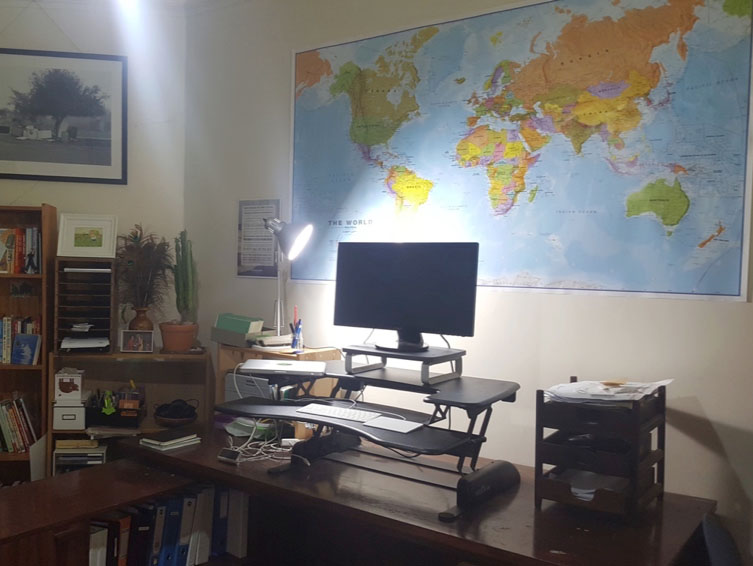
Every time you meet someone new from another country, make it a fun game to find where he or she live on the map. Want to get a really good sense of where they live? Jump on Google maps and look at the street view.
Other strategies to try:
• Get a sense of how people live in this part of the world by visiting Dollar Street (this brings it to life)
• Jump online and find an online paper created in that part of the world. For example, learning about India? Check out The Times of India. This will give you a sense of the issues the local people are dealing with.
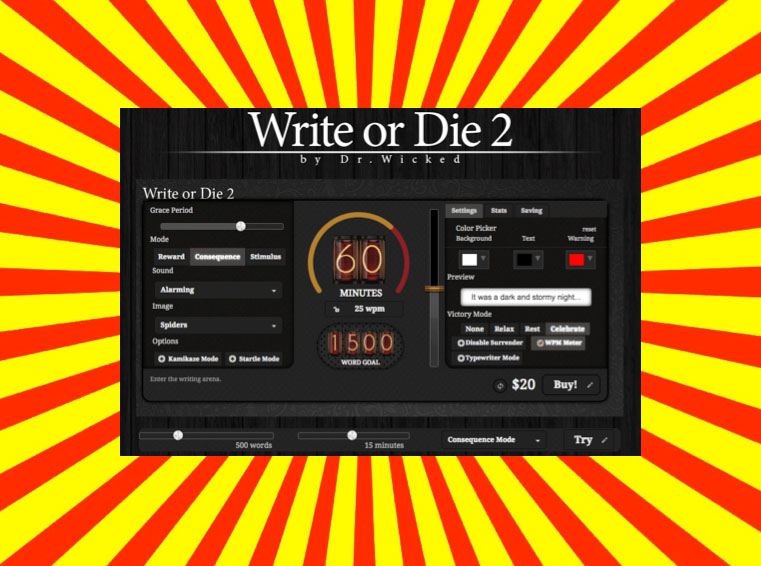
Need to bash out a 1,000 word essay in a short period of time? Then try using the Write or Die app.
The Write or Die app is a writing tool that helps you get words down fast. Here’s how it works: you set goals for how many words and the length of your writing session. Then you select either reward or consequence.
If you select reward, every time you hit a writing milestone a picture of a cute puppy will flash on the screen. Consequence mode will punish you with a red flashing screen and sirens if you’re writing too slowly. If you don’t pick up the pace, the computer will start eating up your words!
Other ways to make writing essays fun for your brain:
• Use different coloured pens and paper
• Select a crazy font on your computer
• Storyboard your essay: create a plan of your essay in picture form
• Dress up in a crazy costume or wear some ridiculous over-the-top item as you write (e.g. a feather boa or a crown).
• Give yourself a sticker every time you hit a writing milestone
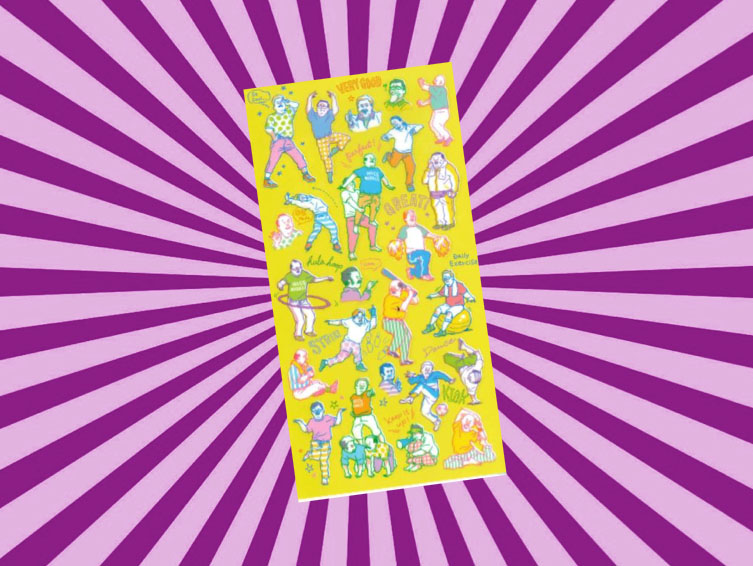
Reading language textbooks can feel like a hard slog. To lighten things up for your brain, you could try:
• Using the Duolingo app
• Use a verb wheel (it feels a bit like being on the show Wheel of Fortune)
• Get out children’s language books from the library
• Go to a restaurant where the staff speak the language and practice your language skills on them
• Create a kids book in the foreign language
• Watch videos and movies in the language
The thought of having to memorise lines for a performance or speech can be overwhelming for your brain. Try doing the following:
• Use the Line Learner app
• Practice your lines in different accents
• Dress up and get fully into character
• Say your lines in an overly dramatic way
• Stand in front of the mirror and practice with yourself
• Drop your lines randomly into conversation with your friends
• Practice with your friends
• Sing your lines
The key here is to trick your brain into thinking it’s not studying for a test or exam. The best way to do this is to create a party atmosphere.
Here’s what I suggest:
1. Invite your friends over to study for a particular subject or topic.
2. Prepare a couple of platters of healthy snacks (e.g. fresh fruit and veggies sticks and dip), get some ingredients to make smoothies, put some background music on (nothing too distracting) and decorate the place with post-it notes, coloured pens and lined paper.
3. When your friends arrive, spend the first 10 minutes catching up (set a timer for this).
4. After socialising, set a timer for 25 minutes. Remove all phones from the space. It’s time to hit your books and/or flashcards.
5. When the timer goes off, everyone gets up and moves for 5 minutes (e.g. do a dance, go for a walk or do some karate kicks).
6. Rinse and repeat steps 4 and 5 until you feel like you need a longer break.
Not keen on throwing a study party? Fair enough. Try these ideas instead:
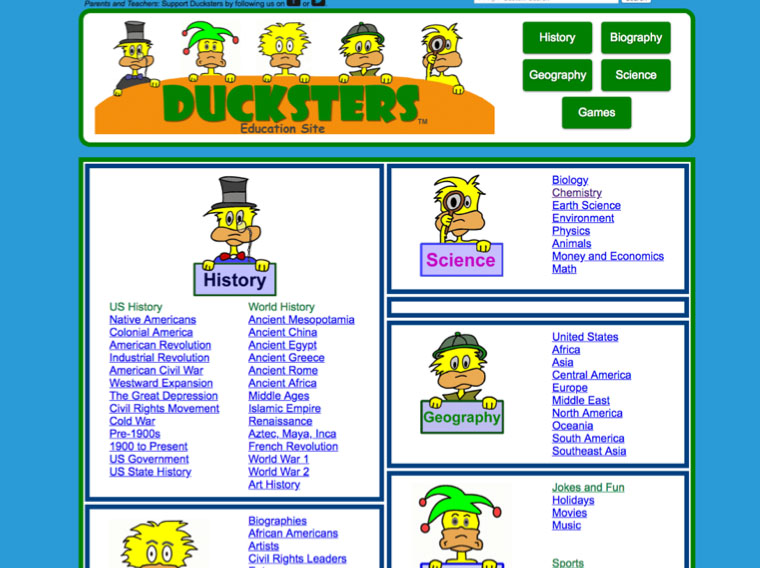
• Jump on Ducksters for simple and straightforward explanations
• Explore ideas in children’s books or any book that makes the topic seem fun for your brain (tip: pictures, illustrations and bright colours help).
• Get a whiteboard and some coloured pens and draw out everything you can remember about the topic. Do this for 5 minutes or until you exhaust your memory. Make sure you then check for gaps in your knowledge and things you incorrectly recalled.
• Venture outside into nature with your textbook, notes and/or flashcards.
Studying doesn’t have to feel like a chore. With a few tricks, you can fool your brain into thinking fun times are ahead! And the thing is when you’re having fun and you’re feeling good, you will learn more. It’s a win-win situation!
The key is to experiment and see what works for you. Keep things new and fresh because your brain loves anything that is new and novel.
Have any other ideas on how to make studying fun and novel for your brain? Feel free to post them below!
Share This:

I didn’t know how to relax. I had one speed and one speed only . . . GO!
When I started dating my husband, he made a comment I never forgot. He said, “You’re intense.”
I laughed it off, thinking, “How ridiculous!”. But looking back, he was right.
Over the last few years, I’ve learnt to live life at multiple speeds and different intensities.
I’ve also learnt how to manage my energy better and pace myself. One thing the pandemic taught me was the importance of slowing down and taking regenerative breaks.
For many years, even though I intellectually understood the importance of rest, I struggled to do it.
For some reason, I thought I had to be always working.
My to-do list was something I had to power through. One thing after another. Got that thing done? Quick! Cross it off the list! Onto the next task.
As a student, I developed a bad habit of staying back late at university. As an undergrad, I’d hang out with my psychology friends in the computer labs until nearly midnight (I had to call the university security service to escort me to my car!).
Then, as a PhD student, I’d be in my office working late when everyone else had gone home. I’d buy takeaway that I’d eat alone at my desk. I’d get home late. I’d get to bed late.
How did I feel the next day?
Not great.
The problem with this approach is now glaringly obvious to me: because I was getting less sleep, I started to feel run down, which made it hard for me to focus, do my best thinking, and work efficiently.
Going fast all the time was actually slowing me down.
Then, I met a Brazilian PhD student called Carlos.
Carlos showed me there was a different way to work. A better way. A more sustainable way.

When I first met Carlos, I was taken aback by his beaming smile and infectious laugh.
He seemed genuinely happy, which wasn’t the case for many PhD students.
It wasn’t uncommon to see PhD students glued to their seats for hours with a 2-litre bottle of Coke on their desks. But this was not Carlos’s style.
I learnt that Carlos rode his bike to university every day (partly to save money and partly to clear his mind). He’d take breaks to play soccer and go rock climbing.
With all this activity, you might be wondering whether Carlos was managing to get any work done on his PhD.
He certainly was.
Carlos was super productive as a PhD student.
He was publishing papers and on track to finish his PhD on time, all with a big smile.
Here’s the really interesting thing about Carlos . . .
When he started working on his PhD, he was like me: pushing himself to work long, ridiculous hours.
As an International student, Carlos had a strict deadline for submitting his PhD thesis. At the beginning of his PhD, he told me he was driven by fear that he might not finish the work in time, so working nonstop seemed like the only path forward.
But then Carlos had an epiphany.
He realised he was just as productive when he allowed himself to engage in fun activities (e.g., rock climbing and playing soccer) as when he insisted on pushing himself to work crazy hours without taking any breaks.
This made Carlos realise that he needed to get serious about these fun rest breaks and prioritise them.
Whether Carlos realised it or not, he was emulating the behaviour of top research scientists.
In one longitudinal study, 40 scientists in their 40s were followed for 30 years. These scientists had attended top universities and showed promise in their careers.

The researchers wanted to know the difference between the people who had become top scientists and those who became mediocre scientists.
In other words, what were the top scientists doing that the mediocre scientists weren’t doing?
One of the key differences that stood out was movement.
The top scientists moved a lot more than the mediocre scientists. They engaged in activities such as skiing, hiking, swimming, surfing and playing tennis.
In contrast, the mediocre scientists did a lot less physical activity.
They were more likely to say, “I’m too busy to go hiking this weekend. There’s work I need to catch up on.” They saw physical movement as eating into the time they could be working.

The top scientists thought differently about movement. Moving their bodies was critical to doing good scientific work. It was something they needed to prioritise in their lives.

When I first read about this study, I immediately thought about Carlos. Riding his bike, playing soccer, and rock climbing were all activities that helped him work effectively on his PhD. These weren’t time-wasting activities; they were necessities.
Movement gets you out of your head and grounds you in your body. It also gives you space away from your work, which our minds need when doing complex and challenging tasks.
In addition, as you move your body, your brain is bathed in feel-good chemicals. It’s easier to get things done when you feel good and less stressed. You can have more fun. You come back into balance.
But do all breaks need to involve movement?
Not always. But you should try to find fun activities that you can do away from your desk, phone, or computer.
Do something that lets your mind loose and requires little to no mental effort to execute.
Here are some of my favourite fun break activities:
These fun break activities may not seem like much fun to you. I understand if steaming your clothes sounds boring (I’m even surprised by how much fun this is).
Your job is to discover your own fun break activities. But how do you do this? It’s simple – you follow the Rules of Fun.
Psychologist Risa Williams lays out the Rules of Fun in her brilliant book The Ultimate Anxiety Toolkit.

The Rules of Fun are as follows:
What was fun for you yesterday may not be fun today. That’s okay. Focus on what you find fun today. Only you know what that is.
The activity isn’t something you should find fun. It’s actually fun for you (it brings a smile to your face and a sense of calm).
For example, many Australians love watching the footy, but I don’t enjoy it. I’d much rather head outside, run around, kick a footy, or throw a frisbee. This is fun for me!
Risa Williams also points out that your list of fun activities will need to be updated regularly. She explains that we are constantly changing and evolving, so naturally, what we find fun will change and evolve, too.
Stay flexible and trust your intuition when it comes to the activities you find fun.
Start to listen to your body. Begin to notice what activities leave you feeling good.
The break activity shouldn’t leave you feeling mentally fried or emotionally wrecked. If it does, you’ve violated this rule.

For example, I never feel good when binge-watching a Netflix series or sitting for long periods. In contrast, I nearly always feel good after a walk.
As I mentioned, you need to get out of your head and get grounded in your body.
If you’re stuck in an anxiety loop about a comment or post a friend made on social media, the last thing you want to do is go online. You need to calm down by engaging in a fun activity (away from screens) that brings you back into balance.
You don’t need to fly to Bali or have an expensive massage to take a fun break. You can engage in many free and cheap activities at home and on your own.
Going for a walk around the block is free and easy. Drawing some silly faces on a scrap of paper is free and fun.

In contrast, travelling to the gym to take a cardio class (and getting there on time) feels much harder.
Let’s face it: if the break activity feels difficult or requires a lot of mental or physical effort, time, or money, you’re probably not going to do it.
However, when your fun break activities are easy, you’re more likely to do them again and again.
Little kids know how to have fun. They will happily and instinctively pick up some crayons to draw. They’ll nap without guilt. But as we grow older, many of us lose our sense of fun and our ability to rest. We start to take ourselves too seriously.
But no matter your age, it’s time to get serious about taking fun breaks.
I’ve discovered that the key to feeling satisfied and content is to feel calm and grounded. But you can’t feel calm and grounded if you constantly push yourself to do more and more.
To keep your body and mind in balance, you need to insert fun breaks into your day. These fun breaks are not a waste of time. They are essential for feeling good, fully alive, and doing your best work.
So, in the spirit of fun, what will you do to give yourself a fun break? Follow the rules of fun and experiment with different activities. Be playful!
Finally, do you know what happened to Carlos? He’s gone on to become a respected Senior Lecturer at a top university in Australia . . . and he still enjoys going rock climbing.
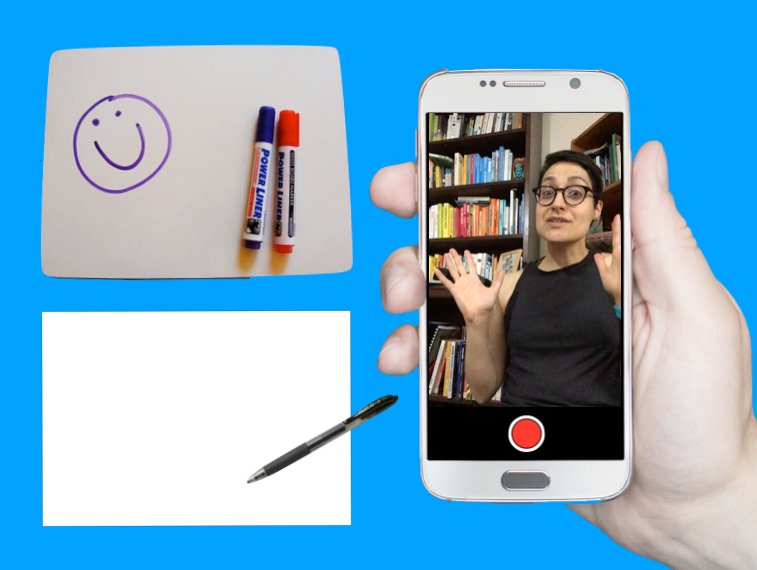
Research shows active recall (aka retrieval practice) is a highly effective strategy for remembering information. This strategy will take your studies and your grades to the next level.
Active recall involves bringing information to mind without looking at your books and notes.
I have spent the last 30 days experimenting with this excellent learning strategy. In this blog, I’ll share what I did and how I kept the process interesting for my brain.
I no longer need to study for tests and exams.
So, why did I spend 30 days using active recall strategies?
In my line of work, I need to constantly come up with new and original content to present to students. I also need to memorise this content. Why?
Because if I was to read from a sheet of notes or text heavy slides that would be really boring for students. I want to connect with students and to do this, I have to be able to deliver the content off the top of my head with speed and ease.
This is where active recall enters the picture.
Active recall helps to speed up the learning process. It allows you to learn more in less time.
Below I share some of the ways I use active recall to learn new presentation content. Keep in mind, you can use all of these strategies to prepare for an upcoming test or exam.
Whiteboards are wonderful learning tools. Here’s how I use a whiteboard to do active recall . . .
I push my speech notes to the side, so I can’t look at them. Then I grab a marker and say to myself, “What can you remember? Go!”.
I write out everything I can remember on the whiteboard. Once I’ve exhausted my memory, I pick up my notes and check to see how I went (using a red marker to make corrections).
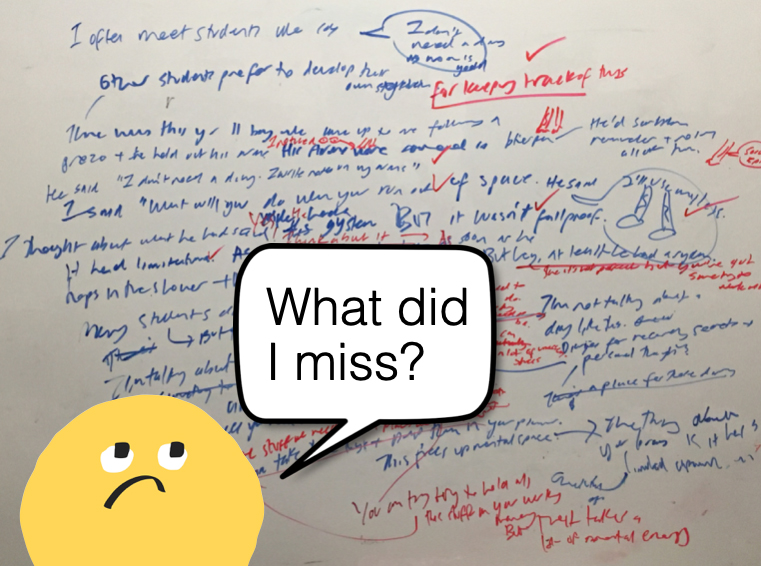
No whiteboard? No problem!
I pick up a pen and sheet of paper and start scribbling out whatever I can remember on the topic. When I get stuck, I pause and take a few deep breaths as I try to scan my brain for the information.
I regularly remind myself that it is okay to not remember the content. “This is how the process goes!”, I say to myself. There is no point beating myself up. That only leads to feelings of misery and not wanting to do active recall practice.
After having a shot at it, I take out my notes, pick up a red pen, and begin the process of checking to see how I went.
Sick of writing? I get it.
Try drawing out the information instead. Alternatively, you can use a combination of words and pictures, which is what I often do.
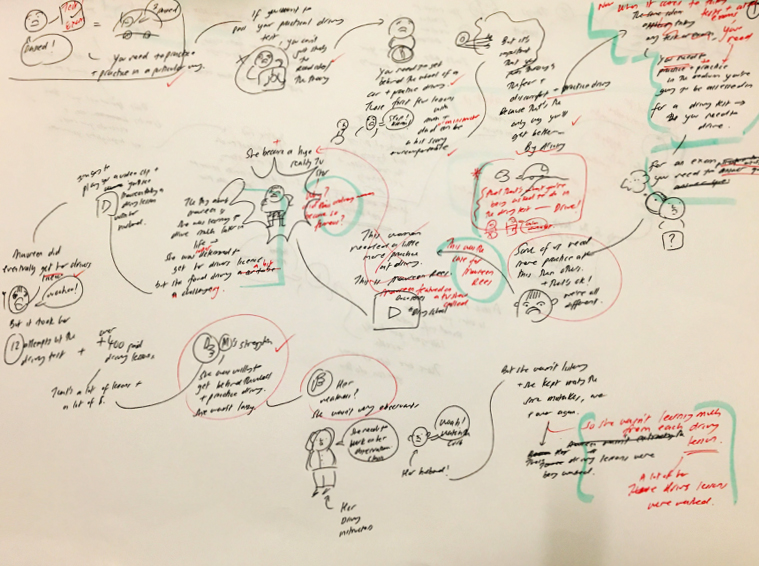
Grab a blank piece of paper (A3 size is best) and create a mind map of everything you can remember on a topic (no peeking at your notes). Then check your notes or the original mind map to see what you remembered correctly and incorrectly.
Writing and drawing out information can take time. If you want to speed up the process, you can talk to yourself.

But don’t do this in your head. It’s too easy to just say “Yeah, yeah, I know this stuff!”. You need to speak it out loud as this forces you to have a complete thought. Then, check your notes to see how you went.
The only downside with this approach is you don’t have a tangible record of what you recalled, which brings me to the next strategy . . .
I make videos of myself presenting the content (without referring to my notes). Although I use special software and tools to make my videos, you don’t need any fancy equipment. Your phone will do the job. Here’s what you can do . . .
Set your phone up so the camera is facing you. Now hit the record button and tell the camera what you’re going to do active recall on. Have a shot at explaining the idea. Then stop recording and hit the play button.

Watching yourself struggle to remember information is often hard viewing. But this is where it’s super important to double down on telling yourself kind thoughts (e.g., “I’m still learning this content. It’s going to be rusty and feel clunky – that’s okay!”).
You need to take a deep breath and keep watching because the video will give you valuable feedback.
For example, if you stop midsentence and you don’t know how to proceed, that tells you something: you don’t know this stuff so well! Make a note. This part of the content needs your attention.
Hand your notes over to a friend, parent, or sibling. Now get them to ask you questions on the content.
I sat with my mum and showed her a print out of my slides for a new presentation. The slides were just pictures (no text).
As I went through the slides, I explained the ideas to mum. I made notes of any sections I was rusty on. Mum also asked lots of questions, which allowed me to think more deeply about the content.
When it came crunch time (a few days before the final presentation), I printed out my presentation slides (16 per page) and used each slide as a prompt. I’d look at the slide and say, “What do I need to say here?”.

Sometimes I wrote out what I’d be saying in relation to each slide (without looking at my notes). Then I checked my original notes to make sure I hadn’t forgotten anything.
It’s really important that you don’t skip the stage of checking to see how you went, especially as you become more confident with the content.
At times, I found myself thinking “I know this stuff! I don’t need to check my notes” but then another part would say, “You better just check . . . just to be on the safe side”.
I’m glad I forced myself to check because more often than not I would discover that I had missed a crucial point.
Zines are cute little booklets you can create on any topic you like. They are fun to make, so I thought I’d try making a mini zine on the main points of some new content I had to learn.
I folded up an A4 page into a booklet and then I sketched out the main points on each panel.
I create a deck of flashcards on some key ideas (question on one side and the answer on the back) and then I test myself with them.
I read the question and before flipping the card, I write out the answer on a sheet of paper or say it out loud. Then I check to see how I went.
The beauty of flashcards is they are small and portable (they can easily fit in your pocket or bag). Whenever you have a spare minute or two, you can get a little active recall practice in.
It’s not enough to do active recall just once on the content you need to learn. For best results, you want to practice recalling the information several times over a period of time.
I didn’t follow a strict schedule for the 30 days. I had my notes for each important chunk of information I had to learn pinned to eight different clipboards.
Every morning, I’d pick up a different clipboard and I’d practice that specific content. I knew as long as I’d had a good night’s sleep in between practice sessions that the information was being strengthened in my brain.
Doing active recall is a bit like doing a high intensity workout: it can be exhausting. But you must remember, just like a high intensity exercise session is an effective way to train and get fit, active recall is an effective way to learn. Unlike less effective strategies (e.g., rereading and highlighting), you can learn a lot in a short space of time with active recall.
The key is to expect the process to be a little uncomfortable. Don’t fight the discomfort. If you trust the process and persevere, it won’t be long before you begin to see amazing results.
Just because active recall is challenging to do that doesn’t mean you can’t have fun with it.
Using a combination of different active recall strategies is one way to keep things fresh and interesting for your brain. But you may wish to try the following things to add a little boost of fun to your active recall sessions:
• Use a different type of pen
• Use a different coloured pen
• Change the type of paper or notebook you use (e.g., instead of using lined paper, use blank A3 paper)
• Incorporate movement into your active recall sessions (e.g., walk and test yourself with some flashcards)
• Change your study environment (e.g., go to the library or study outside)

Like I said, active recall is challenging to do, especially when you first start learning new content. You can feel awkward and clumsy. For this reason, it’s easy to make excuses to get out of doing it (e.g., “I’m too tired”, “I’m not ready to do it”, and “It’s not the right time”).
This is where you need to harness the power of habits.
Find a set time in your day to do a little active recall practice. For instance, during my 30 days of active recall, I scheduled my practice sessions for first thing in the morning. I knew after I washed my face, I would sit down to practice.
Incorporating active recall into my morning routine worked really well for me. I was getting the hardest thing done first thing in the day. And once it was done, I could relax. It was done and dusted!
At a certain point, I became more confident with the content and I found I was on a roll. I felt motivated to do active recall.
This is when I started to look for spare moments in the day to squeeze in a few extra mini practice sessions.
For example, one day I found myself waiting in a car. I grabbed a paper shopping bag and started scribbling out the content onto the bag. As soon as I got home, I checked the shopping bag against my notes.
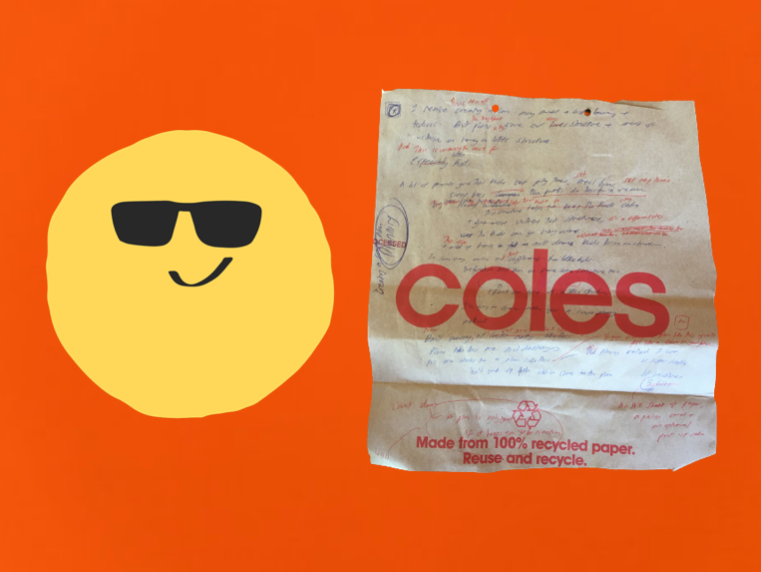
I hope you can see that there’s no one set way to do active recall. This is a highly effective strategy you can be creative with. As long as you’re testing yourself and checking to see how you went, you can’t go wrong.
And if you do make a mistake? It’s no big deal. If you check to see how you went, you won’t embed the error in your long-term memory.
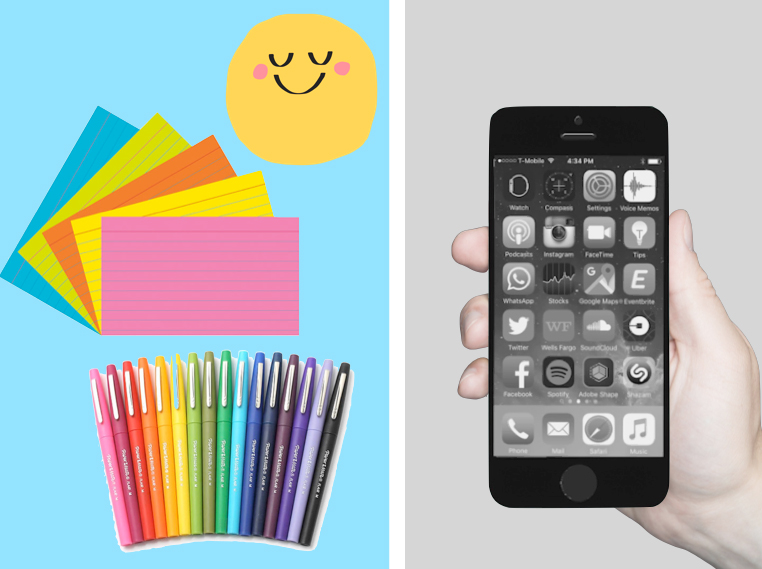
This is no accident. This is a deliberate design decision.
It’s the same reason why fast food logos are often warm reds, yellows, and orange tones. These colours jump out at us. They create a sense of excitement and urgency.
In his book Drunk Tank Pink, Dr Adam Alter argues colour is a hidden force in our lives that can shape the way we think, feel, and behave.

In this blog, I’m going to explore how you can use colour as a tool to help you study more effectively and keep your brain focused and engaged on the task at hand.
There is whole field of research dedicated to exploring the impact of different colours.
One fascinating study looked at the impact of a particular tone of pink (Baker-Miller Pink/Drunk Tank Pink) that appeared to sap people of their energy. Researcher Dr Alexander Schauss found staring at this shade of pink could lower people’s heart rate and pulse compared to staring at other colours.
A 7-month trial was conducted in which prison confinement cells were painted in this pink shade. According to Dr Schauss, when people were exposed for just 15 minutes to this pink colour in their prison cell, it made them more relaxed, less aggressive, and reduced the incidence of violent behaviour.

But before you race off to the hardware store to buy a tin of pink paint, you need to understand a few simple things about the psychology of colour.
The research suggests that colour can act as a powerful trigger. It can cue different emotions, thoughts, and behaviours. For instance, when you see a red Stop Sign or light, this captures your attention.
But how we react to colour also comes down to personal preference and particular contexts. Colour can have different meanings in different contexts (e.g., on Valentine’s Day red generally symbolises romance rather than “Danger! Look out!”).
The bottom line is this: when it comes to colour you need to experiment to see what works for you.
Colour can evoke particular states (e.g., a state of calm or alertness). It can also perk up your brain and transform a dry, boring subject into something that’s a little bit more novel and interesting for your brain.
Below I share 9 ways you can use colour to study and work more effectively.
There’s something about a brightly coloured post-it note that captures our attention. This is why I love using post-it notes to help focus my mind and stay on track.
On a post-it note, I create a list of no more than three things that I need to do. Once I’ve completed those tasks, I scrunch up the post-it and throw it in the bin. This action feels surprisingly satisfying! I’ll then grab a fresh post-it note (often in a different colour) to create a new list.
If I’m not sure how to get started with a task (e.g., Task: Write blog post on colour), I’ll grab another post-it note and I’ll scribble down the first tiny action I can take to kick-start the process (e.g., Tiny action: Open Word document).
If you have trouble finding your study materials for each subject and they all look the same or are scattered all over the house, you can use colour to make it easier for you to find what you need.
Try assigning a particular colour to a subject. This makes it easier to stay organised and identify your materials. At home, I assign a light blue to my exercise files and folders. When it’s time to plan my workout for the day, I look for my light blue files and folders.
A simple and cheap way to colour code your materials without investing in brand new stationery is to gather a collection of paint swatches from your local hardware store. You can repurpose these as labels by cutting them into smaller sections and sticking them on your files, notebooks, etc.
Testing yourself with flashcards is a highly effective way to study for a test and/or exam. You can create your own flashcard decks by purchasing index cards in a range of different colours.
Try assigning certain colours to different subjects. Alternatively, you can simply pick a colour you want to work with depending on how you feel.
There are no hard and fast rules. Feel free to mix up your flashcard colours to keep things fresh for your brain.
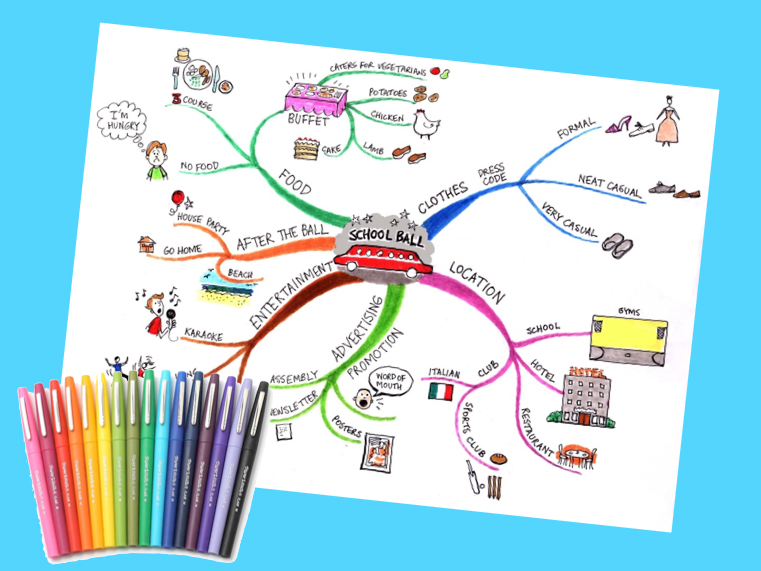
Creating a mind map on a topic is a simple way to combat study fatigue and inject a little colour and creativity into your study sessions.
Although using different coloured pens isn’t absolutely essential for mind mapping, it’s well worth doing. I use different colours to create the different branches on my mind maps.
I have dozens of colourful mind maps at home. Despite my lack of drawing skills, these mind maps look great and are fun to review primarily due to the different coloured branches.
It’s important that you feel good in your study environment. If you feel good in your study space, you’re more likely to sit down and study there.
I’ve decorated my workspace by putting up colourful posters, inspiring and funny pictures, and artwork on my walls.
If you don’t have access to artwork/posters, you can print out colourful pictures and quotes of things that make you feel good. The addition of a few indoor plants can also help to liven up your space as well as purify the air.
Fluorescent highlighters feel really good to use. It can feel both fun and satisfying to strike things off your to-do list. You can also use these pens to time block different tasks/events in your diary and draw your attention to important tasks that you need to do.
Word of warning: When it comes to studying for a test or exam, I don’t recommend highlighting your books and/or notes as a way to learn. I know it feels good but research shows it’s an ineffective way to learn.

Red pen is often associated with failure and criticism. This is why seeing a teacher’s comments scribbled in red pen can trigger negative emotions in many of us.
Generally, we don’t like reading comments written by others in red pen. It feels nasty! But it turns out if you use a red pen to correct your own work, this can help you to pick up more errors.
Dr Adam Alter discusses one study that looked at the difference between using a blue pen and a red pen to correct an essay. Students who used a blue pen picked up on average 19 errors. In contrast, students using a red pen picked up an average of 24 errors.
But using a red pen has its limitations! If you are trying to solve a problem or taking a test, using a red pen can backfire by activating ‘avoidance motivation’. This is a distracting state of mind that can impair a student’s ability to solve problems and increase stress levels.
As a rule of thumb, use a blue or black pen when solving problems and taking tests. But when you need to cast a more critical eye on your work (e.g., in the proofreading phase), switch to using a red pen.
A lot of us use our phones as an easy way to escape from the boredom and discomfort we experience when doing our work. The apps on our phones are like candy. They are designed to be highly addictive and hijack our attention.
This is where you can be strategic with how you use colour: you can make your phone look more like a tool (and less like a toy) by turning on greyscale mode.
Viewing your phone in greyscale is a completely different experience to using it in full-colour mode. As a year 8 student recently shared with me:
“When I made my phone greyscale, it made it really boring to use.”
Try it and see for yourself!
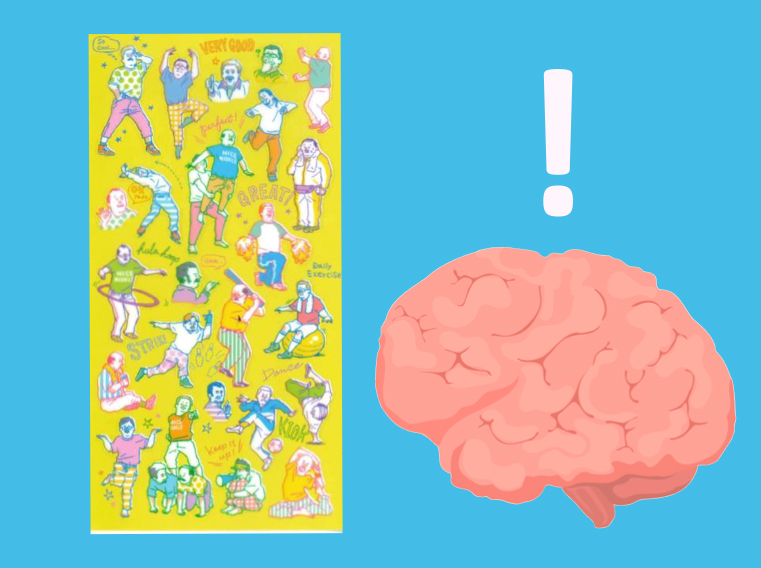
This strategy may seem juvenile. If it reminds you of being back in primary school and receiving gold stars, hear me out.
Too often we don’t stop to acknowledge and appreciate ourselves for accomplishing tasks. We finish one thing and we immediately shift our focus to the next task on our to-do list.
When you work this way, your work routine can quickly become soul destroying and your motivation can take a dive.
This is why every so often I pull out my fun stamps and colourful sheets of stickers. After completing a task, I pause and acknowledge what I’ve done by giving myself a stamp or a fun sticker. It’s a little celebration.
For some reason, my brain responds particularly well to quirky Japanese stickers featuring ogisan (Japanese grandfathers) exercising. We’re all different, so explore what stamps and stickers work for you.
Colours are lot of fun! Incorporating a little more colour into your studies and work life can take things to the next level and perk up your brain when it needs a little motivational boost.
But the colours that I like may not be the colours that you like. Your colour preferences may also vary from day to day. Notice the colours that make you feel good and have fun seeing how you can incorporate them into your study sessions.
Dr Jane Genovese delivers interactive and engaging study skills sessions for Australian secondary schools. She has worked with thousands of secondary students, parents, teachers and lifelong learners over the past 15 years.
Get FREE study and life strategies by signing up to Dr Jane’s newsletter:
© 2025 Learning Fundamentals